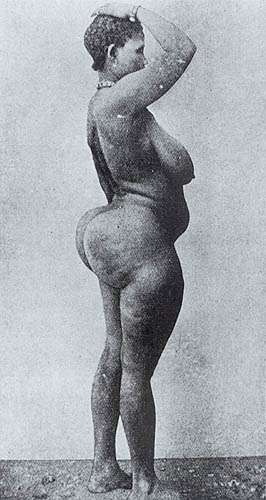Steatopygia
Steatopygia is the state of having substantial levels of tissue on the buttocks and thighs. This build is not confined to the gluteal regions, but extends to the outside and front of the thighs, and tapers to the knee producing a curvaceous figure. The term is from the Greek στέαρ stéar meaning "tallow" and πυγή pugḗ meaning "rump".[1][2][3][4]
| Steatopygia | |
|---|---|
 | |
| A Khoisan woman displaying steatopygia | |
| Pronunciation |
|
Steatopygia, a genetic characteristic leading to increased accumulation of adipose tissue in the buttock region, is found in women of sub-Saharan African origin, most notably (but not solely) among the Khoisan of southern Africa and Pygmies of central Africa. It has also been observed among the Andamanese people, such as the Onge tribe, in the Andaman Islands of the Indian Ocean. This genetic characteristic is prevalent among women but also occurs to a lesser degree in men.[5]
Steatopygia would seem to have been a characteristic of a population which once extended from the Gulf of Aden to the Cape of Good Hope, from which peoples the Khoisan and Pygmies may be remnants.[6][7] Among the Khoisan, it begins in infancy and is fully developed by the time of the first pregnancy. While the Khoisan afford the most noticeable examples of its development, it is by no means rare in other parts of Africa.
It has been suggested that this feature was once more widespread. Paleolithic Venus figurines, sometimes referred to as "Steatopygian Venus" figures, discovered from Europe to Asia presenting a remarkable development of the thighs, and even the prolongation of the labia minora, have been used to support this theory. Whether these were intended to be lifelike or exaggeratory, even idealistic, is unclear. These figures however do not qualify as steatopygian, since they exhibit an angle of approximately 120 degrees between the back and the buttocks, while steatopygia is diagnosed by modern medical standards at an angle of about 90 degrees only.[8]
In Victorian England, freak shows often exploited women with steatopygia. One of the most well-known examples was a South African Khoikhoi woman named Saartjie Baartman.[9]
See also
References
- "Steatopygia". Dictionary.com Unabridged. Random House. Retrieved 2016-01-22.
- "Steatopygia". Merriam-Webster Dictionary. Retrieved 2016-01-22.
- "Steatopygia". Oxford Dictionaries. Oxford University Press. Retrieved 2016-01-22.
- "MP3 file". Content.answers.com. Retrieved 8 June 2016.
- "Chapter 5: A Physical Examination". Andaman.org. Archived from the original on July 10, 2012. Retrieved 2012-08-13.
- Semino O, Santachiara-Benerecetti AS, Falaschi F, Cavalli-Sforza LL, Underhill PA (January 2002). "Ethiopians and Khoisan Share the Deepest Clades of the Human Y-Chromosome Phylogeny". Am. J. Hum. Genet. 70: 265–8. doi:10.1086/338306. PMC 384897. PMID 11719903.
- Cummings, Vicki; Jordan, Peter; Zvelebil, Marek (Jul 2014). The Oxford Handbook of the Archaeology and Anthropology of Hunter-Gatherers. Oxford: Oxford University Press. p. 1152. ISBN 9780199551224.
- Softpedia, Stefan Anitei. "What is Steatopygia?". news.softpedia.com/. Retrieved 4 September 2016.
- Magazine, Justin Parkinson BBC News. "The significance of Sarah Baartman". Bbc.co.uk. Retrieved 8 June 2016.